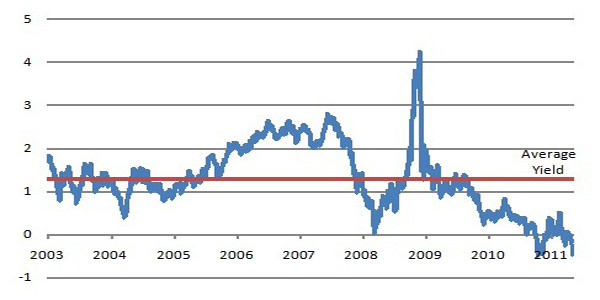A recent report in MarketWatch argued that investors in TIPS are getting swindled. Since their introduction in 1997, TIPS (Treasury Inflation-Protected Securities) have been popular with investors for providing guaranteed protection from inflation. This is in contrast with regular Treasury bonds, which lose purchasing power during periods of high inflation. However, recent TIPS yields have been declining to the point where the Five-Year TIPS currently has a real yield of -0.33%. This means that investors in Five-Year TIPS will receive an annual return equal to the future rate of inflation, minus an additional third of a percent. According to the MarketWatch report, this is tantamount to theft:
…under almost any possible scenario, these bonds are guaranteed to lose you nearly half a percent of your purchasing power, each year, for the next five years — a total loss of 2.5%, guaranteed. It’s crazy. Totally nuts. Some investment losses are unavoidable, but not this one. This one is a lock. Just take some money from your pocket and throw it away. In football terms, this isn’t playing defense. This is taking a safety. Give up points. Of course, these low yields are great news for Uncle Sam. He’s borrowing your money really cheaply; your loss is his gain. But this is one tax that nobody is screaming about — maybe because they haven’t noticed.
So are TIPS really such an awful deal? First, it’s important to mention that longer term TIPS actually have positive yields (the 30-Year TIPS are yielding 1.76% in real terms). It should also be noted that a laddered portfolio of TIPS, or a diversified TIPS fund should have a positive real yield.
In addition, although Five-Year TIPS are guaranteed to lose money in real terms, there is no other investment that is guaranteed to rise over the next five years. Because of low yields, all fixed income investments are guaranteed to lose money in real terms, TIPS are no exception.
The current consensus among forecasters is that inflation will be 2.35% over the next five years. When you subtract this expected inflation from yields, all types of fixed income decline in purchasing power as can be seen in Figure 1. And remember, for municipal and corporate bonds, the yield does not equal the expected return. If any bonds default, your return could be much lower than the stated yield.
Yields Before and After Forecasted 2.35% Inflation as of 5/13/2011
| SECURITY | YIELD BEFORE INFLATION | YIELD AFTER INFLATION | SOURCE |
| Five-Year TIPS | -0.33% | -0.46% | Bloomberg |
| Five-Year Treasuries | 1.81% | -0.53% | Bloomberg |
| Five-Year Municipal Bonds | 1.29% | -1.03% | Bloomberg |
| Five-Year AAA Corporate Bonds | 1.99% | -0.35% | Yahoo Finance |
| Five-Year Bank CD Average | 1.89% | -0.45% | DepositAccounts.com |
Some securities will do better than TIPS after the expected rate of inflation. However, this is assuming that forecasters are perfectly accurate. Some people are worried that inflation could be higher than 2.35%, because of government deficits, a falling dollar and unprecedented quantitative easing by the Federal Reserve.
What would real yields look like under a bad inflation scenario? Figure 2 shows the real yields under a doomsday 5% annual inflation scenario. While TIPS receives the same -0.33% yield, all other securities experience drastic declines in purchasing power.
Yields Before and After 5% Inflation
| SECURITY | YIELD BEFORE INFLATION | YIELD AFTER INFLATION |
| Five-Year TIPS | -0.46% | -0.46% |
| Five-Year Treasuries | 1.81% | -3.04% |
| Five-Year Municipal Bonds | 1.29% | -3.53% |
| Five-Year AAA Corporate Bonds | 1.99% | -2.87% |
| Five-Year Bank CD Average | 1.89% | -2.96% |
So what are the options for an investor who needs real income? There are certain stocks with high dividends, and some high yield bonds sold by companies in distress. But stocks and junk bonds are much more risky than high quality fixed income. Investors can choose to buy bonds with a longer term, but long-term bonds will decline much more in value than short-term bonds if interest rates rise.
Yield of Five-Year TIPS Since 2003
As shown in Figure 3, recent Five-Year TIPS yields are the lowest they’ve ever been. It is likely that in the future they will rise closer to the long-term average of 1.3%. Investors with a long time horizon may find that a few years of low real returns will not derail their retirement plan. In that case, the most prudent strategy may be to stick to the long-term asset allocation strategy. And any diversified fixed income portfolio should take advantage of the inflation-protecting power of TIPS, which, despite current negative yields, are still a good deal.
Source: Federal Reserve


